
DIN48 SIZE MULTI-RANGE ANALOG TIMER
|
 |
 |
 |
 |
Features
1.100-240V AC free-voltage input, 48-125V DC type available
2.Short body - 62.5mm/2.461 inch (screw terminal type)
3.Front panel of IP65 type is protected against water splash and dust
4.Built-in Screw terminals
Screw terminal type is used for easy wiring and reducing additional cost for accessories.
5.0 setting instantaneous output operation
6.Multiple time ranges
-1 s to 500 h (Max.)
7.8 different operation modes: (PM4H-A)
8.Compliant with UL/CSA, CE and LLOYD
Time Range
| Time unit | sec | min | hrs | 10h | |
|---|---|---|---|---|---|
| Scale | |||||
| 1 | Control time range |
0.1s to 1s | 0.1min to 1min | 0.1h to 1h | 1.0h to 10h |
| 5 | 0.5s to 5s | 0.5min to 5min | 0.5h to 5h | 5h to 50h | |
| 10 | 1.0s to 10s | 1.0min to 10min | 1.0h to 10h | 10h to 100h | |
| 50 | 5s to 50s | 5min to 50min | 5h to 50h | 50h to 500h | |
Note: 0 setting is for instantaneous output operation.
PM4H-A/PM4H-S/PM4H-M All types of PM4H timer have multi-time range. 16 time ranges are selectable. 1s to 500h (Max. range) is controlled.
Operation Mode
PM4H-A
( LED lighting
LED lighting  LED flickering T:Setting time t1,t2,ta,tb<T t1+t2=T)
LED flickering T:Setting time t1,t2,ta,tb<T t1+t2=T)
| Operation type | Explanation | Time chart |
|---|---|---|
| Pulse ON-delay (ON) |
・If using a time-limit start when the power is turned on, and a reset when the power is turned off, pins 2 to 6 (screw-tightening pins [2] and [3] )should be shorted ahead of time. ・Turn the operation mode selector switch to the (ON) position. If pins (2) to (6) (screw-tightening pins [2] and [3]) are shorted (the start input is turned on) with the power supply on, the output will go on after the set time has elapsed.
Note) During time-limited operation, the time-limited operation is stopped while the pins (2) to (5) (screw-tightening pins [2] to [5]) are being shorted (the stop input is on). When the pins are released, time-limited operation resumes. |
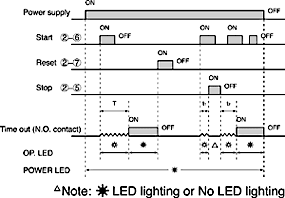 |
| Pulse Flicker (FL) |
・If using a time-limit start when the power is turned on, and a reset when the power is turned off, pins (2) to (6) (screw-tightening pins [2] and [3]) should be shorted ahead of time. ・Turn the operation mode selector switch to the (FL) position. When pins (2) to (6) (screw-tightening pins [2] and [3]) are shorted (the start input is turned on) with the power supply on, the limited time interval begins, and the output goes on after the set time has elapsed. After the output has gone on, it goes off when the set time has elapsed, and this process is subsequently repeated.
Note) During time-limited operation, the time-limited operation is stopped while the pins (2) to (5) (screw-tightening pins [2] to [5]) are being shorted (the stop input is on). When the pins are released, time-limited operation resumes. |
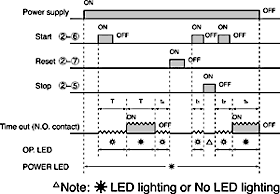 |
| Pulse ON-flicker (FO) |
・If using a time-limit start when the power is turned on, and a reset when the power is turned off, pins (2) to (6) (screw-tightening pins [2] and [3]) should be shorted ahead of time. ・Turn the operation mode selector switch to the (F0) position.
Note) During time-limited operation, the time-limited operation is stopped while the pins (2) to (5) (screw-tightening pins [2] to [5]) are being shorted (the stop input is on). When the pins are released, time-limited operation resumes. |
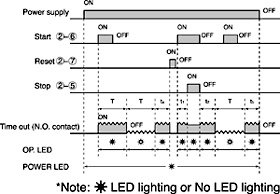 |
| Differential ON/OFF-delay (1) (OF1) |
・Turn the operation mode selector switch to the (OF1) position. When pins (2) to (6) (screw-tightening pins [2] and [3]) are shorted (the start input is turned on) with the power supply on, the output goes on, and after the set time has elapsed, it goes off.
Note) During time-limited operation, the time-limited operation is stopped while the pins (2) to (5) (screw-tightening pins [2] to [5]) are being shorted (the stop input is on). When the pins are released, time-limited operation resumes. |
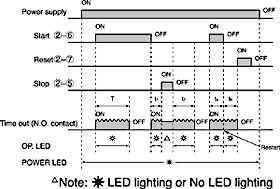 |
| Signal OFF-delay (SF) |
・Turn the operation mode selector switch to the (SF) position.
Note) During time-limited operation, the time-limited operation is stopped while the pins (2) to (5) (screw-tightening pins [2] to [5]) are being shorted (the stop input is on). When the pins are released, time-limited operation resumes. |
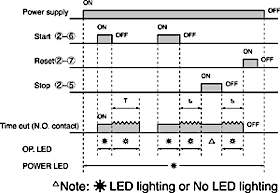 |
| Pulse One-shot (OS) |
・If using a time-limit start when the power is turned on, and a reset when the power is turned off, pins (2) to (6) (screw-tightening pins [2] and [3]) should be shorted ahead of time.
Note) During time-limited operation, the time-limited operation is stopped while the pins (2) to (5) (screw-tightening pins [2] to [5]) are being shorted (the stop input is on). When the pins are released, time-limited operation resumes. |
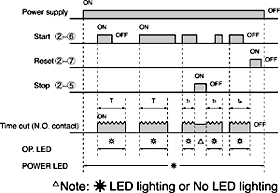 |
| Differential ON/OFF-delay (2) (OF2) |
・Turn the operation mode selector switch to the (OF2) position.
Note) During time-limited operation, the time-limited operation is stopped while the pins (2) to (5) (screw-tightening pins [2] to [5]) are being shorted (the stop input is on). When the pins are released, time-limited operation resumes. |
 |
| Pulse One-cycle (OC) |
・If using a time-limit start when the power is turned on, and a reset when the power is turned off, pins (2) to (6) (screw-tightening pins [2] and [3]) should be shorted ahead of time. ・Turn the operation mode selector switch to the (OC) position.
Note) During time-limited operation, the time-limited operation is stopped while the pins (2) to (5) (screw-tightening pins [2] to [5]) are being shorted (the stop input is on). When the pins are released, time-limited operation resumes. |
 |
1. Keep 0.1s or more for power off time.
2. Keep 0.05s or more for start, stop, reset input time.
<h4 class="HeadingD1">PM4H-S</h4>
( LED lighting
LED lighting  LED flickering T:Setting time)
LED flickering T:Setting time)
| Operation type | Explanation | Time chart |
|---|---|---|
| Power ON-delay | Time limit contact relay When the power supply is turned on, the output goes on after the set time interval has elapsed. When the power supply is turned off, a reset is carried out. |
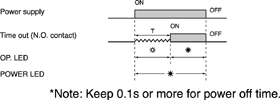 |
1.Keep 0.1s or more for power off time.
<h4 class="HeadingD1">PM4H-M</h4>
( LED lighting
LED lighting  LED flickering T:Setting time)
LED flickering T:Setting time)
| Operation type | Explanation | Time chart |
|---|---|---|
| Power ON-delay (ON) Power Flicker (FL) Power ON-flicker (FO) Power One-shot (OS) Power One-cycle (OC) |
Turn the operation mode selector switch to display the various operations. When the power supply is turned on, the time limit interval begins,and operation is carried out. When the power supply is turned off, a reset is carried out. |
 |
Keep 0.1s or more for power off time. PM4H-M timers do not have each input which is start, reset and stop.


